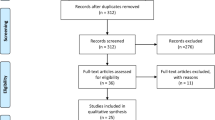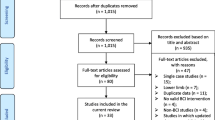Abstract
The aim of this review was to evaluate the evidence for nonpharmacological rehabilitation interventions for motor and cognitive impairment following pediatric stroke. A literature search was conducted using multiple scientific databases. Studies were included if (1) the study population was > 50% pediatric (< 18 years) stroke, (2) a diagnosis of stroke was explicitly stated, (3) there were ≥ 3 pediatric stroke participants included in the study sample, and (4) motor or cognitive outcome measures were used to assess effect of treatment. Levels of evidence were assigned to each study to determine the strength of the evidence for each intervention. A total of 18 articles met inclusion criteria. Most studies (N = 14) examined rehabilitation of the upper limb, with constraint-induced movement therapy (CIMT) as the most common intervention. Overall, the evidence supports the use of CIMT, forced use therapy, repetitive transcranial magnetic stimulation, functional electrical stimulation, and robotics, but suggests no beneficial effect of transcranial direct current stimulation. Very few studies assessed interventions for the lower limb (N = 1) or cognitive impairment (N = 3).
Conclusion: Effective rehabilitation approaches are important for optimizing outcomes in children who have had a stroke. Although the number of published clinical trials has increased in recent years, little evidence-based guidance exists for this clinical population.
What is Known: • Pediatric stroke is a significant cause of disability in children that is often associated with long-term motor and cognitive sequelae. • There is a need to establish a knowledge base regarding available evidence-based rehabilitation therapies for this clinical population. | |
What is New: • Most studies examining interventions for motor function focus on upper limb rehabilitation, whereas few studies have investigated interventions for improving lower limb or cognitive impairment. • An important gap exists regarding evidence-based rehabilitative treatment approaches for pediatric stroke. |

Similar content being viewed by others

Abbreviations
- AHA:
-
Assisting Hand Assessment
- BBT:
-
Box and Blocks Test
- CIMT:
-
Constraint-induced movement therapy
- COPM:
-
Canadian Occupational Performance Measure
- FES:
-
Functional electrical stimulation
- MA:
-
Melbourne Assessment
- PAFT:
-
Pediatric Arm Function Test
- PCT:
-
Prospective controlled trial
- PDMS:
-
Peabody Developmental Motor Scale
- PEDro:
-
Physiotherapy evidence database
- PMAL:
-
Pediatric Motor Activity Log
- PRISMA:
-
Preferred Reporting Items for Systematic Reviews and Meta-Analyses
- RCT:
-
Randomized controlled trial
- rTMS:
-
Repetitive transcranial magnetic stimulation
- tDCS:
-
Transcranial direct current stimulation
- WMTB-C:
-
Working Memory Test Battery for Children
References
Bernson-Leung ME, Rivkin MJ (2016) Stroke in neonates and children. Pediatr Rev 37:463–477
Calgary Pediatric Stroke Program (2018) Pediatric stroke: Definitions and terminology. https://ucalgary.ca/perinatalstroke/definitions_terminology
Cardenas JF, Rho JM, Kirton A (2011) Pediatric stroke. Childs Nerv Syst 27:1375–1390
Carlson HL, Ciechanski P, Harris AD, MacMaster FP, Kirton A (2018) Changes in spectroscopic biomarkers after transcranial direct current stimulation in children with perinatal stroke. Brain Stimul 11:94–103
Carswell A, McColl MA, Baptiste S, Law M, Polatajko H, Pollock N (2004) The Canadian occupational performance measure: a research and clinical literature review. Can J Occup Ther 71:210–222
Dalkey N, Helmer O (1963) An experimental application of the DELPHI method to the use of experts. Manag Sci 9:458–467
DeVeber G (2005) In pursuit of evidence-based treatments for paediatric stroke: the UK and chest guidelines. Lancet Neurol 4:432–436
deVeber G, Roach ES, Riela AR, Wiznitzer M (2000) Stroke in children: recognition, treatment, and future directions. Semin Pediatr Neurol 7:309–317
Eve M, O'Keeffe F, Jhuty S, Ganesan V, Brown G, Murphy T (2016) Computerized working memory training for children following arterial ischemic stroke: a pilot study with long-term follow-up. Appl Neuropsychol 5:273–282
Fasoli SE, Fragala-Pinkham M, Hughes R, Hogan N, Krebs HI, Stein J (2008) Upper limb robotic therapy for children with hemiplegia. Am J Phys Med Rehabil 87:929–936
Foley NC, Bhogal SK, Teasell RW, Bureau Y, Speechley MR (2006) Estimates of quality and reliability with the physiotherapy evidence-based database scale to assess the methodology of randomized controlled trials of pharmacological and nonpharmacological interventions. Phys Ther 86:817–824
Friedman N (2009) Pediatric stroke: past, present and future. Adv Pediatr Infect Dis 56:271–299
Gillick BT, Krach LE, Feyma T, Rich TL, Moberg K, Thomas W, Cassidy JM, Menk J, Carey JR (2014) Primed low-frequency repetitive transcranial magnetic stimulation and constraint-induced movement therapy in pediatric hemiparesis: a randomized controlled trial. Dev Med Child Neurol 56:44–52
Gillick BT, Feyma T, Menk J, Usset M, Vaith A, Wood TJ, Worthington R, Krach LE (2015) Safety and feasibility of transcranial direct current stimulation in pediatric hemiparesis: randomized controlled preliminary study. Phys Ther 95:337–349
Goeggel Simonetti B, Cavelti A, Arnold M, Bigi S, Regenyi M, Mattle HP, Gralla J, Fluss J, Weber P, Hackenberg A, Steinlin M, Fischer U (2015) Long-term outcome after arterial ischemic stroke in children and young adults. Neurology 84:1941–1947
Gordon A, Connelly A, Neville B, Vargha-Khadem F, Jessop N, Murphy T, Ganesan V (2007) Modified constraint-induced movement therapy after childhood stroke. Dev Med Child Neurol 49:23–27
Greenham M, Gordon A, Anderson V, Mackay MT (2016) Outcome in childhood stroke. Stroke 47:1159–1164
Greenham M, Anderson V, Mackay MT (2017) Improving cognitive outcomes for pediatric stroke. Curr Opin Neurol 30:127–132
Hebert D, Lindsay MP, McIntyre A, Kirton A, Rumney PG, Bagg S, Bayley M, Dowlatshahi D, Dukelow S, Garnhum M, Glasser E, Halabi ML, Kang E, MacKay-Lyons M, Martino R, Rochette A, Rowe S, Salbach N, Semenko B, Stack B, Swinton L, Weber V, Mayer M, Verrilli S, DeVeber G, Andersen J, Barlow K, Cassidy C, Dilenge ME, Fehlings D, Hung R, Iruthayarajah J, Lenz L, Majnemer A, Purtzki J, Rafay M, Sonnenberg LK, Townley A, Janzen S, Foley N, Teasell R (2016) Canadian stroke best practice recommendations: stroke rehabilitation practice guidelines, update 2015. Int J Stroke 11:459–484
Jeong JW, Lee J, Kamson DO, Chugani HT, Juhasz C (2015) Detection of hand and leg motor tract injury using novel diffusion tensor MRI tractography in children with central motor dysfunction. Magn Reson Imaging 33:895–902
Juenger H, Linder-Lucht M, Walther M, Berweck S, Mall V, Staudt M (2007) Cortical neuromodulation by constraint-induced movement therapy in congenital hemiparesis: an FMRI study. Neuropediatrics 38:130–136
Kapadia NM, Nagai MK, Zivanovic V, Bernstein J, Woodhouse J, Rumney P, Popovic MR (2014) Functional electrical stimulation therapy for recovery of reaching and grasping in severe chronic pediatric stroke patients. J Child Neurol 29:493–499
Kim CT, Han J, Kim H (2009) Pediatric stroke recovery: a descriptive analysis. Arch Phys Med Rehabil 90:657–662
King AA, White DA, McKinstry RC, Noetzel M, Debaun MR (2007) A pilot randomized education rehabilitation trial is feasible in sickle cell and strokes. Neurology 68:2008–2011
Kirton A, deVeber G (2015) Paediatric stroke: pressing issues and promising directions. Lancet Neurol 14:92–102
Kirton A, Chen R, Friefeld S, Gunraj C, Pontigon AM, deVeber G (2008) Contralesional repetitive transcranial magnetic stimulation for chronic hemiparesis in subcortical paediatric stroke: a randomised trial. Lancet Neurol 7:507–513
Kirton A, Andersen J, Herrero M, Nettel-Aguirre A, Carsolio L, Damji O, Keess J, Mineyko A, Hodge J, Hill MD (2016) Brain stimulation and constraint for perinatal stroke hemiparesis: the PLASTIC CHAMPS trial. Neurology 86:1659–1667
Kirton A, Ciechanski P, Zewdie E, Andersen J, Nettel-Aguirre A, Carlson H, Carsolio L, Herrero M, Quigley J, Mineyko A, Hodge J, Hill M (2017) Transcranial direct current stimulation for children with perinatal stroke and hemiparesis. Neurology 88:259–267
Krishnamurthi RV, deVeber G, Feigin VL et al (2015) Stroke prevalence, mortality and disability-adjusted life years in children and youth aged 0–19 years: Data from the global and regional burden of stroke 2013. Neuroepidemiology 45:177–189
Mackay MT, Wiznitzer M, Benedict SL, Lee KJ, Deveber GA, Ganesan V, International Pediatric Stroke Study Group (2011) Arterial ischemic stroke risk factors: the international pediatric stroke study. Ann Neurol 69:130–140
Mallick AA, O'Callaghan FJ (2010) Risk factors and treatment outcomes of childhood stroke. Expert Rev Neurother 10:1331–1346
Mallick AA, Ganesan V, Kirkham FJ, Fallon P, Hedderly T, McShane T, Parker AP, Wassmer E, Wraige E, Amin S, Edwards HB, Tilling K, O'Callaghan FJ (2014) Childhood arterial ischaemic stroke incidence, presenting features, and risk factors: a prospective population-based study. Lancet Neurol 13:35–43
Mittal SO, ThatiGanganna S, Kuhns B, Strbian D, Sundararajan S (2015) Acute ischemic stroke in pediatric patients. Stroke 46:e32–e34
Moher D, Liberati A, Tetzlaff J, Altman DG, PRISMA Group (2009) Preferred reporting items for systematic reviews and meta-analyses: the PRISMA statement. J Clin Epidemiol 62:1006–1012
Moseley AM, Herbert RD, Sherrington C, Maher CG (2002) Evidence for physiotherapy practice: a survey of the physiotherapy evidence database (PEDro). Aust J Physiother 48:43–49
Rich TL, Menk J, Krach LE, Feyma T, Gillick BT (2016) Repetitive transcranial magnetic stimulation/behavioral intervention clinical trial: long-term follow-up of outcomes in congenital hemiparesis. J Child Adolesc Psychopharmacol 26:598–605
Rickards T, Sterling C, Taub E, Perkins-Hu C, Gauthier L, Graham M, Griffin A, Davis D, Mark VW, Uswatte G (2014) Diffusion tensor imaging study of the response to constraint-induced movement therapy of children with hemiparetic cerebral palsy and adults with chronic stroke. Arch Phys Med Rehabil 95:506–514.e1
Royal College of Paediatrics and Child Health (2017) Stroke in childhood: clinical guideline for diagnosis, Management and rehabilitation
Rudolph S, Hiscock H, Price A, Efron D, Sewell J, South M, Wake M (2009) What research questions matter to Australian paediatricians? National Delphi Study. J Paediatr Child Health 45:704–710
Sackett D, Straus S, Richardson W, Rosenberg W, Haynes R (2000) Evidence-based medicine: how to practice and teach EBM. Churchill Livingstone, Toronto, ON
Steinlin M, O'Callaghan F, Mackay MT (2017) Planning interventional trials in childhood arterial ischaemic stroke using a Delphi consensus process. Dev Med Child Neurol 59:713–718
Studer M, Boltshauser E, Capone Mori A, Datta A, Fluss J, Mercati D, Hackenberg A, Keller E, Maier O, Marcoz JP, Ramelli GP, Poloni C, Schmid R, Schmitt-Mechelke T, Wehrli E, Heinks T, Steinlin M (2014) Factors affecting cognitive outcome in early pediatric stroke. Neurology 82:784–792
Taub E, Griffin A, Uswatte G, Gammons K, Nick J, Law CR (2011) Treatment of congenital hemiparesis with pediatric constraint-induced movement therapy. J Child Neurol 26:1163–1173
Tsze DS, Valente JH (2011) Pediatric stroke: a review. Emerg Med Int.
Willis JK, Morello A, Davie A, Rice JC, Bennett JT (2002) Forced use treatment of childhood hemiparesis. Pediatrics 110:94–96
World Health Organization (2007) International classification of functioning, disability and health (ICF). World Health Organization, Geneva
Yang JF, Livingstone D, Brunton K, Kim D, Lopetinsky B, Roy F, Zewdie E, Patrick SK, Andersen J, Kirton A, Watt JM, Yager J, Gorassini M (2013) Training to enhance walking in children with cerebral palsy: are we missing the window of opportunity? Semin Pediatr Neurol 20:106–115
Yerys BE, White DA, Salorio CF, McKinstry R, Moinuddin A, DeBaun M (2003) Memory strategy training in children with cerebral infarcts related to sickle cell disease. J Pediatr Hematol Oncol 25:495–498
Funding
This project was funded by the Heart and Stroke Foundation of Canada and the Canadian Partnership for Stroke Recovery.
Author information
Authors and Affiliations
Contributions
MM was responsible for manuscript conceptualization, literature search, article selection, quality assessment, data extraction, table and figure creation, manuscript drafting and editing, and preparation of the final manuscript for submission; MM wrote the abstract, methods, and results, and contributed to the introduction and discussion. AMc assisted with article selection and wrote the discussion. PF contributed to writing the introduction. NS assisted with article selection, quality assessment, and data extraction. CC and RT provided clinical expertise about stroke rehabilitation throughout the manuscript. AMc, PF, NS, CC, and RT all contributed to manuscript editing.
Corresponding author
Ethics declarations
Conflict of interest
The authors declare that they have no conflict of interest.
Informed consent
Not applicable.
Additional information
Communicated by Mario Bianchetti
Publisher’s note
Springer Nature remains neutral with regard to jurisdictional claims in published maps and institutional affiliations.
Rights and permissions
About this article
Cite this article
Mirkowski, M., McIntyre, A., Faltynek, P. et al. Nonpharmacological rehabilitation interventions for motor and cognitive outcomes following pediatric stroke: a systematic review. Eur J Pediatr 178, 433–454 (2019). https://doi.org/10.1007/s00431-019-03350-7
Received:
Revised:
Accepted:
Published:
Issue Date:
DOI: https://doi.org/10.1007/s00431-019-03350-7



